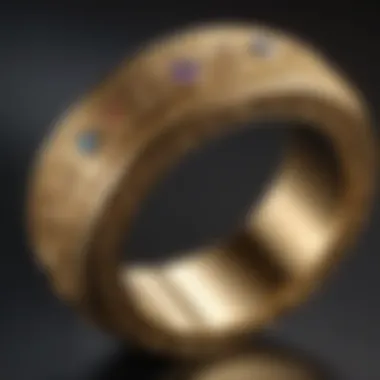How to Identify Authentic Gold Jewelry: A Complete Guide


Intro
Identifying genuine gold jewelry can be overwhelming for many. With various options available in the market, distinguishing between authentic and fake items becomes crucial. This article aims to break down the necessary steps to confidently determine if a piece of jewelry is indeed made of gold. By examining its characteristics, understanding common testing methods, and evaluating purity, both collectors and casual wearers can navigate their choices with clarity.
In this guide, we will explore how to visually inspect gold jewelry, perform hand tests, and recognize the importance of hallmarks. Together, these aspects will provide a strong foundation to accurately ascertain the authenticity of gold pieces.
Overview of Gemstones and Minerals
While the primary focus is on gold, an appreciation of the broader context of gemstones and minerals may enrich understanding. Gold jewelry often features gemstones, enhancing aesthetics and value. Therefore, it is beneficial to have knowledge of gemstones and minerals.
History of Gemstone and Mineral Use
Throughout history, gemstones and minerals have held significant value. Cultures worldwide have utilized them not just for adornment but also as symbols of power and status. Ancient civilizations, such as the Egyptians and Romans, crafted intricate jewelry adorned with precious stones to demonstrate wealth and divine connection. Understanding this historical significance can inform current trends in jewelry design and investment.
Significance in Culture and Society
Beyond mere decoration, gemstones and minerals serve as cultural markers. For instance, diamonds symbolize love, while sapphires often represent wisdom. Different societies place varying importance on specific stones, linking them to rituals or beliefs. This interplay between culture and material value adds layers of meaning that collectors and enthusiasts might consider when examining the jewelry they possess or purchase.
Assessing Gold Jewelry
With a foundational understanding of gemstones, we return to gold specifically. Gold jewelry is valued not only for its beauty but also for its intrinsic worth. Not all gold jewelry is created equal; thus, understanding purity and authenticity is essential.
Visual Inspection
Begin with an inspection. Look closely for signs of wear or discoloration. Genuine gold will not tarnish over time. If the piece appears dull or shows discoloration, it may be plated or made from a lower-quality alloy. Pay attention to the color: high-karat gold should exhibit a rich, vivid hue.
Hand Testing
You can assess the jewelry by conducting a hand test. A small piece can be rubbed across a ceramic tile. If it leaves a gold streak, it is a sign of authenticity. Also, feeling the weight of the piece can help—gold is denser than many alternatives, so heavier pieces often indicate true gold.
Hallmark Significance
Hallmarks can also provide insights into the authenticity and purity of gold jewelry. These are often stamped on the inner part of a ring or the clasp of a necklace. Numbers typically represent the karat value. For instance, 14k signifies 14 parts gold and 10 parts other metals, indicating a level of purity. Understanding hallmarks can help you assess whether a piece is worth its stated value.
End
As you learn how to identify genuine gold jewelry, remember that knowledge is power. By familiarizing yourself with key characteristics and testing methods, you enhance your ability to make informed decisions. This, in turn, tells you not just about the jewelry itself, but also about your personal taste and investment confidence.
Engaging with gold jewelry is not merely a transactional activity; it’s a deeper involvement with history, culture, and aesthetic appreciation. This guide serves as a stepping stone for anyone looking to become more adept at recognizing and valuing gold jewelry. As you explore this journey, you may find that the elegance of gold goes hand-in-hand with a newfound confidence in your jewelry choices.
Intro to Gold Jewelry
Gold jewelry has held a significant place in human culture and society for centuries. Understanding how to identify genuine gold jewelry is essential for collectors, gemstone enthusiasts, and jewelry designers. Today, a vast market exists with various alloys and imitations, increasing the need for clarity. This article focuses on necessary methodologies to determine authenticity, ensuring that individuals make informed decisions.
Importance of Authenticity
The authenticity of gold jewelry is paramount. Counterfeit items and imitations can often look remarkably similar to genuine gold. This makes it easy for consumers to be misled. For collectors, owning authentic pieces can significantly impact value. Junvenile jewelry might lack intrinsic value, and knowing how to identify real gold helps prevent financial loss. Additionally, the emotional connection to valuable pieces makes authenticity vital. Proper knowledge and skills in identifying gold can safeguard both investment and sentiment.
Understanding Gold Composition
Gold exists in various purities and forms, with its composition being a crucial factor in its value and appearance. The most common forms of gold found in jewelry include 10K, 14K, 18K, and 24K, each representing the amount of pure gold mixed with other metals.
- 10K Gold: Contains 41.7% gold, with other metals like copper and zinc.
- 14K Gold: Comprises 58.3% gold, popular for its balance between durability and value.
- 18K Gold: Contains 75% gold, known for its richness in color and higher value.
- 24K Gold: Represents pure gold, not mixed with other metals but is softer and less durable.
Understanding these compositions allows individuals to assess the value, durability, and aesthetics of jewelry. Each type serves different purposes, from everyday wear to high-value collectibles.
"Authenticity assurance is not just about value; it's about a deeper connection to history and craftsmanship."


With this foundational knowledge, the journey into further evaluations of gold jewelry can be effectively navigated. Identifying gold is not merely a skill; it's an art that combines scientific understanding with sensory perception. The next steps will delve into the characteristics of gold, offering more insights into its physical properties and color variations.
Characteristics of Gold
Understanding the characteristics of gold is essential in identifying genuine gold jewelry. This section delves into the physical properties and color variations that define gold's uniqueness. Recognizing these traits aids not only in authenticity verification but also in appreciating the value and beauty of gold.
Physical Properties
Gold possesses several distinctive physical properties. The most notable is its density. Gold is dense, measuring approximately 19.3 grams per cubic centimeter. This density means that a piece of gold feels heavier than it looks. Weighing the item can offer immediate insights into its content.
Another significant property is its malleability. Gold can be shaped into thin sheets or intricate designs without breaking, which is a crucial aspect in jewelry making. It is also resistant to tarnish. Unlike other metals, gold maintains its luster and does not corrode easily, which adds to its appeal as a material for jewelry.
When examining jewelry, consider:
- Weight: A heavier item may indicate a higher gold content.
- Flexibility: Real gold can bend without breaking.
- Condition: A well-preserved shine suggests authenticity.
Color Variations in Gold
Gold is available in various colors, owing to its alloying processes. Common varieties include yellow gold, white gold, and rose gold. Yellow gold maintains the natural hue of pure gold, while other types are created by mixing gold with different metals. For example, white gold typically includes palladium or nickel to create a silver-like appearance, and rose gold includes copper for a warm, pinkish tone.
Understanding these color variations is crucial. If you encounter a piece labeled as gold but with an unusual hue, it might require further scrutiny. It is also important to note that the purity of the gold can influence its color. Higher karat gold tends to have a richer color, while lower karat gold appears paler. For example, 24-karat gold is bright yellow, while 10-karat gold may appear more diluted and less vibrant.
Gold’s color can also be an aesthetic preference in jewelry design, appealing to different tastes among collectors and enthusiasts. Understanding these factors enables a more informed evaluation of jewelry.
It is essential to check not only the color but also the karat when assessing gold, as purity affects both the hue and value.
Visual Inspection Techniques
Visual inspection plays a crucial role in determining whether jewelry is made of gold. This method allows both experienced collectors and casual observers to make initial assessments without the need for invasive testing. The key to successful visual inspection lies in understanding specific characteristics of gold and recognizing what to look for during the examination.
When assessing gold jewelry visually, one should observe multiple elements, such as color, surface texture, and overall construction. These factors can provide valuable insights into the authenticity of the piece. Additionally, this approach can often reveal obvious flaws or irregularities, enhancing the evaluation process.
Examining the Color
Gold is known for its distinct yellow hue, but it is important to note that the color can vary depending on the karat and the types of metals combined with it. For instance, 14K gold has a more subtle yellow appearance compared to 24K gold, which has a rich and vibrant color. Moreover, white gold is often alloyed with metals like palladium or nickel, giving it a silvery appearance, while rose gold typically has a pinkish tint due to the addition of copper.
When inspecting the color, consider looking for uniformity across the entire piece. Any sudden changes in shade or inconsistent coloration can be red flags indicating that the item may not be pure gold. A genuine gold piece should also exhibit a depth of color, not just surface shine. To enhance your examination, ensure that the lighting conditions are appropriate. Natural light is ideal for evaluating color accurately, as artificial lighting can sometimes distort hues.
Checking for Nicks and Scratches
Wear and tear can reveal much about the quality of jewelry. Checking for nicks and scratches is essential when assessing the condition of gold items. Real gold is relatively soft. It is not uncommon to find some minor signs of wear on vintage or frequently worn pieces. However, excessive scratching or deep nicks may indicate lower-quality metal or even a lack of authenticity.
Pay close attention to high-contact areas, such as clasps and edges, where scratches tend to accumulate. If you discover substantial flaws, it may signal that the piece is either a lower karat or possibly a gold-plated item. Additionally, look at the craftsmanship surrounding the scratches. Quality craftsmanship often reflects genuine materials and attention to detail.
Assessing Weight and Density
Gold is denser than many other metals, making weight an important factor in identifying authenticity. When examining jewelry, you can estimate density by comparing the weight of the item to its size and shape. Genuine gold jewelry tends to feel heavier than it appears.
If you can, weigh the piece and compare it to similar-sized items made from known materials. This can provide insight into its authenticity. A significant discrepancy in weight may cause suspicion regarding the content of the jewelry. It is useful to familiarize yourself with the weight of gold versus other metals to make accurate comparisons more effectively.
It's important to remember that while visual inspection techniques can provide initial insights, they should be followed up with further testing for a conclusive assessment of authenticity.
Common Testing Methods
Importance of Common Testing Methods
Understanding how to test whether jewelry is indeed gold is crucial for anyone involved in purchasing or collecting gold pieces. Common testing methods serve as practical tools to verify authenticity, as they provide clear indicators of what the metal is made of. By employing these methods, one can avoid costly mistakes when acquiring jewelry. Each method offers unique advantages and potential drawbacks, which can be important depending on the context of the purchase. Gaining proficiency in these tests equips jewelry enthusiasts with the knowledge needed to make informed decisions.


Acid Testing
Acid testing is one of the more traditional methods for confirming gold content. This method involves applying a testing acid to a small, inconspicuous area of the jewelry. Different acids are used for various karats of gold—14k, 18k, and so on. If the metal reacts with the acid, it often indicates a lower gold content or a different metal altogether. It is essential to be cautious with this method, as it does involve chemicals that can damage some jewelry pieces.
- Procedure: Start by cleaning the area where you will apply the acid. Then, carefully scratch the gold piece on a testing stone to create a tiny mark. Next, drop the appropriate acid on that mark and observe the reaction.
- Outcome: Depending on the reaction, you can determine the gold purity. No reaction typically indicates genuine gold, while a change in color suggests lower-quality metal.
"Acid testing is effective, but the risks of damage to the item must be carefully weighed before proceeding."
Magnet Test
The magnet test offers a quick and non-invasive way to evaluate the authenticity of gold jewelry. Gold is not magnetic, so if a piece is attracted to a magnet, it likely contains other metals. This test, while simple, does not outright determine purity and should be used in conjunction with other methods for more reliable results.
- Procedure: Obtain a strong magnet and slowly bring it close to the jewelry. Observe if the piece is attracted to the magnet.
- Outcome: If the jewelry sticks to the magnet, it is not made of pure gold. A lack of attraction suggests it may be genuine gold. However, some gold-plated or gold-filled items may also not respond to magnets, so this test has its limitations.
Electronic Testing
Electronic testing devices provide another layer of precision in assessing the authenticity of gold jewelry. These tools operate through electrical resistance and can quickly determine the gold content without damaging the piece. They have become quite popular due to their user-friendly design and efficiency.
- Procedure: Place the jewelry in contact with the testing device's probe. The device will deliver an electric current through the metal, providing a readout of its purity.
- Outcome: Electronic testers often give immediate results, with readings expressed in karats. This method, however, can be costly, and the accuracy may vary with different models.
Understanding Gold Hallmarks
Understanding gold hallmarks is a crucial aspect when assessing the authenticity of gold jewelry. Hallmarks serve as guarantees of quality and purity, providing valuable information that can protect both buyers and sellers. Jewelry enthusiasts, collectors, and designers all benefit from recognizing hallmarks, as these marks indicate the reliability of measurements and craftsmanship.
Hallmarks can often represent a link to the maker's reputation. Knowing the significance of a hallmark helps to differentiate between genuine gold and imposters. This knowledge is essential for making informed purchasing decisions, negotiating prices, and ensuring that what you acquire retains its value over time.
What are Hallmarks?
Hallmarks are official marks that are stamped on precious metal items, including gold jewelry. These marks vary by country and often include a combination of symbols, numbers, and letters that indicate the metal's purity and sometimes the maker's identity. The most recognized hallmark represents the karat weight, for instance, "750" indicates 18-karat gold, meaning 75% pure gold.
Hallmarking began centuries ago as a practice to protect consumers from fraud. Today, regulatory bodies supervise the hallmarking process to ensure consistency and accuracy in the precious metal trade. Thus, it signifies transparency and accountability in the jewelry market.
Interpreting Hallmark Information
Interpreting hallmark information can be straightforward once you understand what the components signify. Aside from karat measurements, hallmarks might include the manufacturer's symbol or initials, an assay office mark, and additional marks that confirm the item’s authenticity.
- Karatage: This indicates the purity level. Common karat values include:
- Maker’s Mark: This could be a distinctive design or initials that signify the jeweler.
- Assay Office Mark: This indicates where the item was tested for purity.
- 24k (99.9% gold)
- 18k (75% gold)
- 14k (58.3% gold)
- 10k (41.7% gold)
Understanding these components helps to verify authenticity and confirm the item's market value.
Common Hallmarks in Gold Jewelry
Several common hallmarks can help identify genuine gold jewelry. Here's a brief overview of some widely recognized examples:
- British Hallmarks: Include the lion passant for 9k, 14k, or 22k gold, along with the year mark.
- American Standards: Often marked with 14k, 18k, or 22k; some will carry a G for gold-filled items.
- European Marks: A series of stamps that may include a crown for high-quality gold.
When examining jewelry, knowing these hallmarks and their meanings can serve as a quick guide to authenticity.
Hallmarks not only provide legitimacy but sometimes reveal a piece's historical context, enhancing its appeal to collectors and enthusiasts.
Professional Appraisal Options
In the journey of identifying genuine gold jewelry, professional appraisal serves as a vital step. Appraisers are experts equipped with the knowledge and tools to assess jewelry accurately. Their evaluations can unveil the quality, purity, and overall value of your item, providing confidence in your investment or sentimental piece. Engaging a qualified professional ensures that you are not relying solely on visual inspections or rudimentary testing methods, which may not always provide definitive answers.
When considering a professional appraisal, it's important to understand what a qualified appraiser brings to the table. Their experience and expertise are fundamental in discerning subtle details that may escape an untrained eye. In many instances, jewelry can possess unique characteristics, and a professional appraiser can identify marks or features that confirm authenticity or purity. This not only enhances your understanding of the piece but also might influence its market value.


Additionally, a professional appraisal can offer peace of mind. Knowing that your jewelry has been evaluated by an expert gives you a sense of assurance, particularly if it's a significant financial investment or a cherished family heirloom.
Thus, pursuing professional appraisal options is beneficial for anyone who values the art of jewelry collection or simply wishes to know more about their items.
Finding a Qualified Appraiser
Finding a qualified appraiser is critical to standing the test of time in your investment. Start by seeking recommendations from trusted sources such as jewelers or fellow collectors. Online platforms can also provide leads. Websites like the American Society of Appraisers and the International Society of Appraisers list certified professionals.
Consider verifying the appraiser’s credentials. Look for certifications from recognized organizations, as they often indicate a level of expertise and ethical standards that is essential in the appraisal process. Check reviews and testimonials, as past client experiences can reveal insights about the appraiser's reliability and depth of knowledge.
Visit the appraiser's office if possible. This not only allows you to assess their professionalism but also to gauge their familiarity with gold jewelry. Engaging in a conversation can help clarify their expertise and approach to appraisals.
What to Expect from an Appraisal
When you submit your jewelry for appraisal, you can expect a thorough and detailed process. The appraiser will begin by examining the piece visually. They will look for specific hallmarks, underlying materials, and overall craftsmanship.
An important part of the appraisal involves testing. This may include measuring the gold’s purity using techniques such as acid testing or employing specialized tools to gauge karat weight. Expect a discussion of the item's historical context and market standards, providing insights not only into the piece’s value but also its significance.
After the assessment, the appraiser will provide you with a written report. This documentation outlines their findings, including the jewelry's assessed value, relevant characteristics, and their professional opinion. It serves as an important record that may be necessary for insurance purposes or resale considerations. Keep in mind, while appraisals are valuable, they are snapshots of value at a specific moment in time, so periodic reevaluations are wise in a fluctuating market.
"Professional appraisals validate the story and investment behind your jewelry, connecting emotion with expertise."
In summary, the journey to understand your gold jewelry's authenticity and value may be complex, but professional appraisals streamline this process to deliver clarity and assurance.
Resources for Further Evaluation
Understanding how to determine if jewelry is gold is complex. Thus, having reliable resources for further evaluation is crucial. These resources can enhance your knowledge, support practical testing, and provide context about gold jewelry. Using these tools and guides offers advantages such as informed decision-making and increased confidence in assessments. Researching is part of a broader effort to avoid poorly informed investments. Knowing where to turn for help can make a significant difference in the evaluation process.
Online Tools and Guides
Many online platforms provide valuable tools and guides for determining gold's authenticity. Websites often feature comprehensive articles detailing various testing methods. Additionally, some platforms offer calculators to help analyze the value based on current market prices.
Some popular online resources include:
- Wikipedia: Offers a wealth of information about gold and jewelry.
- Britannica: Provides credible articles that dive into gold’s properties and characteristics.
- Reddit: Users share their experiences and recommendations for testing jewelry.
You can also find instructional videos on platforms like YouTube. These videos demonstrate practical techniques for checking gold. They show methods that range from simple visual assessments to more advanced tests. Such visual aids can clarify concepts that are hard to grasp through text alone.
Books and Publications
Books about jewelry appraisal and gold's characteristics can be excellent resources. They offer in-depth perspectives and expert insights not always found online. By reading reputable publications, you can learn about the history and science behind gold. Several books explore the jewelry market, helping you understand gold's place in it.
Consider looking for these types of literature:
- Jewelry Making and Design: Guides on crafting gold jewelry can provide insights.
- Gold and Silver Buying Guide: These books teach the consumer about making purchases safely.
- Research Publications: Academic articles that analyze gold properties in detail.
In summary, combining online tools with printed literature creates a robust resource base. This comprehensive approach supports informed assessments of gold jewelry authenticity. The more you know, the better your decisions will be.
Finale
Summarizing Key Points
- Visual Inspection: We discussed how to evaluate color, weight, and the presence of nicks or scratches. These features provide initial clues regarding authenticity.
- Common Testing Methods: From acid testing to electronic testing, each method has its specifics tailored for different circumstances. Understanding each allows for better accuracy in determining gold content.
- Hallmarks: Knowledge of what hallmarks mean, including common types, enhances confidence in assessing jewelry. Recognizing these markers can be instrumental in identifying the origin and quality of gold items.
Encouraging Vigilance in Jewelry Evaluation
In the realm of jewelry evaluation, vigilance cannot be stressed enough. The jewelry market has both high-quality pieces and imitations. Knowledge is key when navigating this diverse landscape.
A few considerations include:
- Always seek reputable sources, whether buying or appraising jewelry.
- Familiarize yourself with both established and emerging testing techniques.
- Engage with the community, seeking insights from fellow collectors or experts to aid in evaluation.
- Research, maintain a notebook of notes and observations for reference.
By encouraging a careful and informed approach to jewelry evaluation, you can better protect yourself from potential pitfalls. Ultimately, being educated about these details contributes to both enjoyment and security in your jewelry investments.







